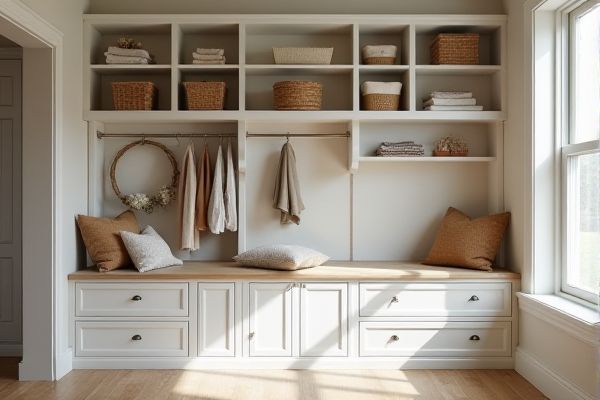
Cubby storage offers open compartments that allow easy access and visibility, ideal for organizing smaller items or displaying essentials, while drawer storage provides concealed spaces that protect contents from dust and maintain a cleaner appearance. Deciding between cubby storage vs drawer storage depends on your organizational needs and aesthetic preferences, so explore the rest of the article to find the best solution for your space.
Table of Comparison
| Feature | Cubby Storage | Drawer Storage |
|---|---|---|
| Design | Open compartments, easy access | Enclosed, sliding compartments |
| Visibility | High visibility of contents | Contents hidden from view |
| Organization | Best for categorizing items by size or type | Ideal for small items and clutter management |
| Space Efficiency | Requires wall or vertical space | Utilizes under-counter or under-table space |
| Access | Quick item retrieval | More secure, but slower access |
| Use Cases | Books, baskets, toys, shoes | Clothing, utensils, tools, paperwork |
| Maintenance | Easy to clean, dust-prone | Protected from dust, harder to clean inside |
| Cost | Generally lower cost | Higher cost due to hardware |
Introduction to Cubby Storage and Drawer Storage
Cubby storage offers open compartments ideal for easy access and visible organization, making it perfect for sorting items by category or size. Drawer storage provides enclosed spaces that protect belongings from dust and maintain a tidy appearance, ideal for smaller items or personal belongings. Choosing between cubby and drawer storage depends on your need for visibility versus concealment in your organization system.
Key Features of Cubby Storage
Cubby storage features open compartments designed for easy access and visibility, making it ideal for organizing items like books, toys, and shoes. Its modular design allows for customizable configurations and scalable storage solutions suitable for homes and offices. Unlike drawer storage, cubbies offer quick item retrieval without the need to open or close, enhancing convenience and organization.
Key Features of Drawer Storage
Drawer storage offers smooth sliding mechanisms for easy access and organization of items, making it ideal for storing small to medium-sized belongings. Its enclosed design helps protect contents from dust, moisture, and damage, enhancing the longevity of your items. You can maximize space efficiently by utilizing varying drawer sizes tailored to different storage needs, streamlining your home or office organization.
Space Efficiency Comparison
Cubby storage maximizes vertical space and offers flexible compartment sizes, making it ideal for organizing items of various shapes and sizes in a compact area. Drawer storage provides enclosed, stackable units that minimize visible clutter and protect contents from dust but can require more floor space due to pull-out mechanisms. Comparing space efficiency, cubbies excel in customizable open storage, while drawers optimize accessibility and protection, depending on specific spatial constraints.
Organization and Accessibility
Cubby storage offers open compartments that allow you to easily see and access items, making organization straightforward and ideal for frequently used belongings. Drawer storage provides a concealed space that helps keep your items dust-free and out of sight, enhancing tidiness but sometimes limiting quick visibility. Your choice depends on whether you prioritize immediate accessibility or a cleaner, more streamlined appearance.
Design Versatility and Aesthetics
Cubby storage offers open compartments that enhance design versatility by allowing a mix of decorative baskets, books, and display items, creating a dynamic and personalized aesthetic. Drawer storage provides a sleek, streamlined look with concealed compartments that complement minimalist and modern interiors while maintaining a clutter-free environment. Both options can be customized with various materials and finishes to align with specific design themes and enhance overall room aesthetics.
Durability and Maintenance
Cubby storage units, typically made from sturdy wood or plastic, offer high durability and are resistant to dents and scratches, making them ideal for heavy or frequently used items. Drawer storage often incorporates metal rails and sliding mechanisms, which require occasional maintenance to prevent jamming and ensure smooth operation over time. Both storage options benefit from regular cleaning, but drawer systems may demand more upkeep due to moving parts compared to static cubby compartments.
Best Use Cases for Cubby Storage
Cubby storage is ideal for organizing items that require quick access and visible categorization, such as shoes, toys, or office supplies. Its open design allows you to easily locate and retrieve belongings without the hassle of opening drawers. For your home or workspace, cubby storage offers versatile, space-efficient organization suited for frequently used items.
Best Use Cases for Drawer Storage
Drawer storage excels in organizing smaller items like clothing, office supplies, and kitchen utensils, providing easy access while maximizing space. It's ideal for keeping your belongings neatly concealed and dust-free, making it perfect for bedrooms, home offices, and kitchens. The smooth sliding mechanism and customizable compartments enhance usability, making drawer storage the best choice for efficient, clutter-free organization in tight spaces.
Choosing the Right Storage Solution for Your Needs
Cubby storage offers easy visibility and accessibility, making it ideal for organizing toys, shoes, or crafting supplies, while drawer storage provides concealed compartments perfect for keeping smaller items like office supplies or clothing out of sight. Evaluate your space constraints and the type of items you need to store to determine which solution maximizes functionality and aesthetics. Consider materials, size, and ease of access to ensure the storage system complements your lifestyle and room design.
 homyna.com
homyna.com